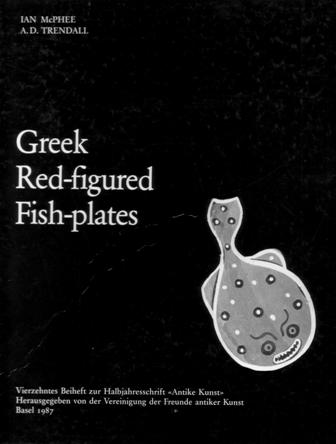Description
GREEK RED-FIGURED FISH-PLATES
by Ian McPhee and A.D. Trendall
This book deals with the red-figured fish-plates that were produced during the fourth century B. C., mainly in Athens and, in particular, in the Greek colonies of Sicily and Southern Italy. About 1000 fragments or whole plates have been listed, of which about five-sixths come from Magna Graecia. The immediate precursors of the figured fish-plates are also considered.
Although red-figured fish-plates have been the subject of a few earlier studies, this is the first attempt to catalogue and to discuss them in a comprehensive manner. The lists are as complete as possible, including fish-plates in private collections or on the market as well as those from regular excavations. The authors have attempted firstly to classify all the fish-plates according to their fabrics (e. g. Attic, Corinthian, Chalcidic; Sicilian, Campanian, Paestan, Apulian), and then, within each fabric, to arrange them in stylistic groups, identifying specific painters where possible. They have also tried to establish a more precise chronology than has been done previously, both a relative chronology based upon stylistic criteria and an absolute one derived mainly from tomb-contexts. On occasion it has been possible, especially for South Italian fish-plates, to suggest correlations between their painters and those of larger red-figured vases. Tentative identifications of the fish have also been given.
The text is accompanied by 68 plates (4 in colour) which illustrate fish-plates from all the fabrics and by all the more important painters, as well as by several diagrams representing the various species of fish depicted upon the plates and a selection of typical profiles.
Die rotfigurigen Fischteller wurden im 4. Jahrhundert v. Chr, besonders in Athen und vor allem in den griechischen Kolonien Siziliens und Unteritaliens hergestellt. Rund 1000 Fragmente oder vollständig erhaltene Teller, davon etwa vier Fünftel aus Grossgriechenland, sind in diesem Buch erfasst. Die unmittelbaren Vorläufer der figürlich bemalten Fischteller werden ebenfalls behandelt.
Rotfigurige Fischteller haben zwar einzeln bereits Interesse gefunden, hier aber wird zum ersten Mal die Gattung als Ganzes behandelt. Der Katalog ist so vollständig wie möglich und erfasst Fischteller in Privatsammlungen oder im Kunsthandel so gut wie diejenigen in öffentlichem Besitz. Die Autoren haben zuerst alle Fischteller nach ihrem Ursprung klassiert als Attisch, Korinthisch, Chalkidisch, Sizilisch, Kampanisch, Paestanisch, Apulisch und sie dann, innerhalb der einzelnen Kapitel, in stilistische Gruppen gegliedert und, wenn möglich, bestimmten Malern zugewiesen. Sie haben ausserdem versucht, eine genauere Chronologie zu begründen, als es bisher geschehen ist, zum einen eine relative Datierung aufgrund stilistischer Kriterien, zum anderen absolute Datierungen, soweit sie sich vor allem aus Grabzusammenhängen erschliessen lassen. Besonders bei den unteritalischen Fischtellern war es gelegentlich möglich, Beziehungen zu den Malern grösserer rotfiguriger Vasen festzustellen. Auch wurden nach Möglichkeit die dargestellten Fische identifiziert.
Der Text wird von 68 Bildtafeln (davon vier farbig) begleitet, die Fischteller aus allen Herstellungszentren und aller bedeutenderen Maler abbilden. Dazu kommen zahlreiche Zeichnungen der verschiedenen Fischarten, die auf den Tellern dargestellt sind, sowie eine Auswahl typischer Profile der Teller.
Gebunden, 170 Seiten, 5 Textabbildungen, 4 Farbtafeln, 64 Bildtafeln
ISBN 3-909064-14-0

